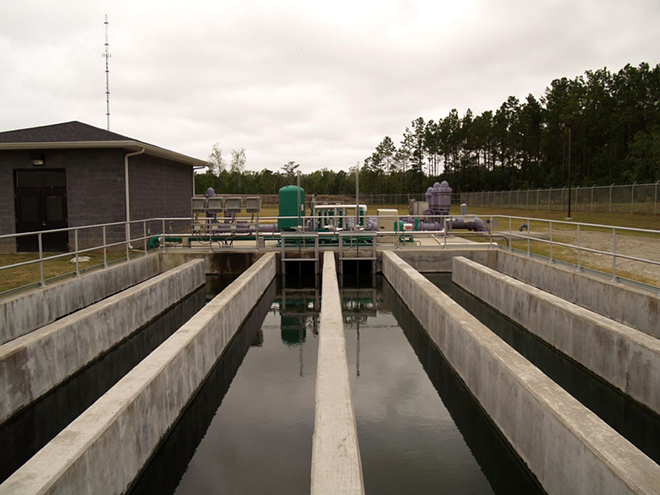
The headlines may have looked bad on Thursday morning, but the sewage overflow that took place at St. Pete's Southwest Water Reclamation Facility was nothing like what happened during heavy rain events in 2015 and 2016. In the wake of several storms, the city had been forced to decide between dumping millions of gallons of partially treated sewage into the bay or letting it back up into the streets and into people's homes.
Simply put, this time around, the Wednesday-night spill of about 50,000 gallons was due to bad timing.
“There's no comparison” to the dumps that cumulatively sent nearly 200 million gallons into the bay over two summers, said Kriseman in a phone interview Thursday.
If it had happened in any year prior to 2015 — and not in an election year — it probably wouldn't have made headlines.
In fact, spills and overflows have happened numerous times over multiple administrations, city records show, and nobody made a big deal out of it. Granted, spills topping a million gallons have been rare.
Here's what happened Wednesday night, Kriseman said, and what the city's doing to ensure it won't happen again.
“As part of our enhancement of the system and expanding the capacity of treatment and storage, the chlorine contact chamber, which is the last phase of treatment — it's where the water receives its chlorination and disinfection before it is sent out to our reclaimed water users — it was taken partially offline yesterday so that a part that was within the chamber could be replaced with an enhanced part. And that's part of the overall project,” he said.
The "overall project" he's referring to is a $300 million overhaul of the city's wastewater infrastructure, which includes greatly expanding the capacity of the Southwest plant. It is handling water from downtown St. Pete in the wake of the closure of the Albert Whitted plant. That plant closed in 2015 with the expectation that, once the repairs to the Southwest facility were complete, the latter would be able to handle flows from both plants even when millions of gallons of stormwater were inundating the system. Critics say the Whitted plant should've stayed open, and some blame Kriseman since it closed under his watch (even though council voted to close it in 2011).
Expanding the Southwest plant, he said, is a piece-by-piece endeavor that sometimes requires temporarily decommissioning equipment so it can be replaced with better equipment. The upgrade to the chlorine contact chamber was expected to take up to ten days.
But, hey, it's summer in Florida.
“Unfortunately, we received heavy flows [Wednesday] and even after a million gallons had been treated and disposed of [as reclaimed water], 50,000 gallons did overflow onto the ground and were absorbed thereafter,” Kriseman said.
Had the rains hit Tuesday instead of Wednesday, he said, there would not have been an overflow.
In that event's wake, the city opted to get the old equipment up and running, and they'll wait until they're in the clear on the weather front.
“In this instance, because the forecast isn't great, they went ahead and they put it back online, and they're looking for a break in the weather forecast so they can take it partially offline again and try to get the repairs completed before another major rain flow,” he said.
In a way, it was kind of a microcosm of the city's sewage problem itself — old infrastructure decommissioned to make way for new infrastructure with the hope that no significant storms will tear through in the interim... and then they do, and all hell breaks loose.
And the Southwest spill happened literally a day after Kriseman held a press conference announcing that the city's enhancements to the plant were ahead of schedule.
Sewage spills and overflows happen all the time; literally hundreds of them have taken place in the last 20 years, city records show, including one at the Southwest plant in which 200,000 gallons of "plant effluvium" spilled at the cite due to "RWF (reclaimed water facility) issues" in March of 2008.
But the general public didn't really know about it, or care, until 2015 — probably because some spills were uncommonly large (despite the city's initial efforts to downplay them) and because it was an opportune moment for political opponents to tack a target on Kriseman's back.
Kriseman is seeking reelection and faces fierce opposition, namely in former mayor Rick Baker — who was mayor during the above-mentioned 2008 snafu and has acknowledged that, yes, spills happen. He places blame for the multimillion-gallon dumps squarely on Kriseman, though, because Kriseman happened to be mayor when Whitted closed. One opponent, Uhuru candidate Jesse Nevel, goes so far as to propose jail time for those involved with the dumps.
The mayor didn't say whether the Whitted plant closure attributed to Wednesday night's overflow.
“It's kind of apples and oranges,” Kriseman said. “The only reason this happened is because we're doing this construction project. If we weren't doing this construction, it wouldn't have happened.”
But Baker sure as hell blames it on the closure.
Whether the spill is five gallons or 50 million, any headline with the word "sewage" is bad for Kriseman, especially as the August 29 election nears. But what's more important than how it looks, he said, is getting things done.
“There's nothing I can do about the optics," Kriseman said. "I hope that people look at the bigger picture of what we're doing and what we're trying to accomplish, because that's what this is all about. This is about taking a system that had not ever really been maintained the way it needed to be overall and finally fixing it so that the public does have more confidence and doesn't have to have the same concerns going forward. That's why we're doing what we're doing.”

